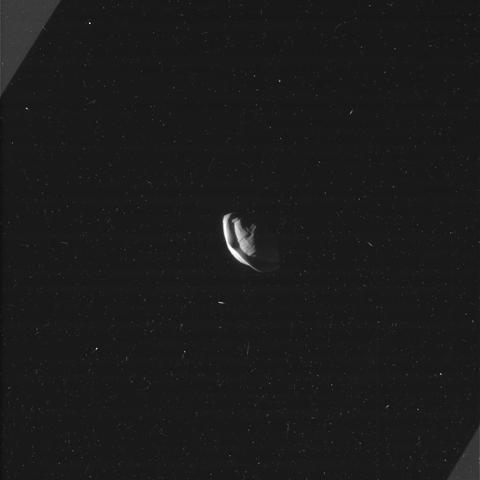We’ve posted several ‘flyover’ videos of Mars that use data from spacecraft. But this video might be the most spectacular and realistic. Created by filmmaker Jan Fröjdman from Finland, “A Fictive Flight Above Real Mars” uses actual data from the venerable HiRISE camera on board the Mars Reconnaissance Orbiter, and takes you on a 3-D tour over steep cliffs, high buttes, amazing craters, polygons and other remarkable land forms. But Fröjdman also adds a few features reminiscent of the landing videos taken by the Apollo astronauts. Complete with crosshatches and thruster firings, this video puts you on final approach to land on (and then take off from) Mars’ surface.
How did Uranus get its name?
The period known as the Scientific Revolution (ca. 16th to the 18th century) was a time of major scientific upheaval. In addition to advances made in mathematics, chemistry, and the natural sciences, several major discoveries were made in the field of astronomy. Because of this, our understanding of the size and structure of the Solar System was forever revolutionized.
Hubble's Glittering Frisbee Galaxy
This image from Hubble’s Wide Field Camera 3 (WFC3) shows a section of NGC 1448, a spiral galaxy located about 50 million light-years from Earth in the little-known constellation of Horologium (The Pendulum Clock). We tend to think of spiral galaxies as massive and roughly circular celestial bodies, so this glittering oval does not immediately appear to fit the visual bill. What’s going on?
Does Mars Have Rings? Not Right Now, But Maybe One Day
How far is Venus from the Sun?
Earth and Venus are often called “sister planets” because they share some key characteristics. Like Earth, Venus is a terrestrial planet (i.e. composed of silicate minerals and metals) and orbits within our Sun’s habitable zone. But of course, they are also some major differences between them, like the fact that Venus’ is atmosphere is extremely dense and the hottest in the Solar System.
Life on Earth is used to gravity – so what happens to our cells and tissues in space?
There’s one force whose effects are so deeply entrenched in our everyday lives that we probably don’t think much about it at all: gravity. Gravity is the force that causes attraction between masses. It’s why when you drop a pen, it falls to the ground. But because gravitational force is proportional to the mass of the object, only large objects like planets create tangible attractions. This is why the study of gravity traditionally focused on massive objects like planets.
Fried egg? Flying saucer? Nope. Just cool closeups of Saturn's moon Pan
Besides Earth, Saturn may be the only other planet where you can order rings with a side of ravioli. Closeup photos taken by the Cassini probe of the the planet’s second-innermost moon, Pan, on March 7 reveal remarkable new details that have us grasping at food analogies in a feeble attempt to describe its unique appearance.
How long is a day on Mercury
Mercury is one of the most unusual planets in our Solar System, at least by the standards of us privileged Earthlings. Despite being the closest planet to our Sun, it is not the hottest (that honor goes to Venus). And because of its virtually non-existence atmosphere and slow rotation, temperatures on its surface range from being extremely hot to extremely cold.
Comets or volcanoes? Scientists are changing their minds about how the Earth’s water got here
The Earth has been the blue planet for as many as 3.8 billion years. Ancient sedimentary rock deposits and lava that cooled into characteristic pillow shapes provide irrefutable evidence that liquid water has existed at the Earth’s surface for at least this long. But given how many barren rocks there are in the galaxy, Earth’s abundant oceans raise the question of where all that water came from.
When galaxies collide, stars suffer the consequences
When galaxies collide, the result is nothing short of spectacular. While this type of event only takes place once every few billion years (and takes millions of years to complete), it is actually pretty common from a cosmological perspective. And interestingly enough, one of the most impressive consequences – stars being ripped apart by supermassive black holes (SMBHs) – is quite common as well.
A Galaxy on the Edge
This colourful stripe of stars, gas, and dust is actually a spiral galaxy named NGC 1055. Captured here by ESO’s Very Large Telescope (VLT), this big galaxy is thought to be up to 15 percent larger in diameter than the Milky Way. NGC 1055 appears to lack the whirling arms characteristic of a spiral, as it is seen edge-on. However, it displays odd twists in its structure that were probably caused by an interaction with a large neighbouring galaxy.
How far is Mercury from the sun?
Mercury is famously known for being a scorching hot world. On the side that is facing towards the Sun, conditions can get pretty molten, reaching temperatures of up to 700 K (427 °C; 800°F) in the equatorial region. The surface is also airless, in part because any atmosphere it could generate would be blown away by solar wind. Hardly surprising, considering it is the closest planet to our Sun.
The search for extraterrestrial life in the water worlds close to home
The discovery of seven exoplanets around a star 40 light years from our Sun has raised the possibility that they could harbour life. Why? Because the astronomers who made the discovery believe some of the planets may have liquid water. And on Earth, wherever there is liquid water, there is life. But we believe we can look much closer to Earth
You are living inside a massive, musical instrument – and here’s what it sounds like
The ancients believed that the Earth was surrounded by celestial spheres, which produced divine music when they moved. We lived, so to speak, in a huge musical instrument. This may sound silly but modern science has proved them right to a certain extent. Satellites recording sound waves resonating with the Earth’s magnetosphere – the magnetic bubble that protects us from space radiation – show that we are indeed living inside a massive, magnetic musical instrument.
Sad about Pluto? How about 110 planets in the solar system instead?
In 2006, during their 26th General Assembly, the International Astronomical Union (IAU) adopted a formal definition of the term “planet”. This was done in the hopes of dispelling ambiguity over which bodies should be designated as “planets”, an issue that had plagued astronomers ever since they discovered objects beyond the orbit of Neptune that were comparable in size to Pluto.
How long is a year on Mercury?
Mercury is a planet of extremes. As the closest planet to our Sun, it experiences extremely high surface temperatures. But since it has virtually no atmosphere to speak of, and rotates very slowly on its axis, it gravitates between extremes of hot and cold. It also means that it’s Sun-facing side experiences prolonged periods of day while its dark side experiences extremely long periods of night.
What is the weather like on Saturn?
Saturn is famous for many things. Aside from its ring system, which are the most visible and beautiful of any gas giant, it is also known for its extensive system of moons (the second largest in the Solar System behind Jupiter). And then there its banded appearance and gold color, which are the result of its peculiar composition and persistent weather patterns.
Through the nuclear looking glass: the moon & the bomb
For centuries, scientists have been attempting to explain how the Moon formed. Whereas some have argued that it formed from material lost by Earth due to centrifugal force, others asserted that a preformed Moon was captured by Earth’s gravity. In recent decades, the most widely-accepted theory has been the Giant-impact hypothesis, which states that the Moon formed after the Earth was struck by a Mars-sized object (named Theia) 4.5 billion years ago.
Black holes are even stranger than you can imagine
What is the surface area of earth?
Whoever coined the phrase “it’s a small world” obviously never tried to travel around it! In truth, the planet’s dimensions are quite impressive, and determining just how big it is took many thousands of years. From astronomers determining that Earth was in fact round (and not a flat disc, cube or ziggurat), to the first successful attempts at circumnavigation, our estimates have changed over time.












